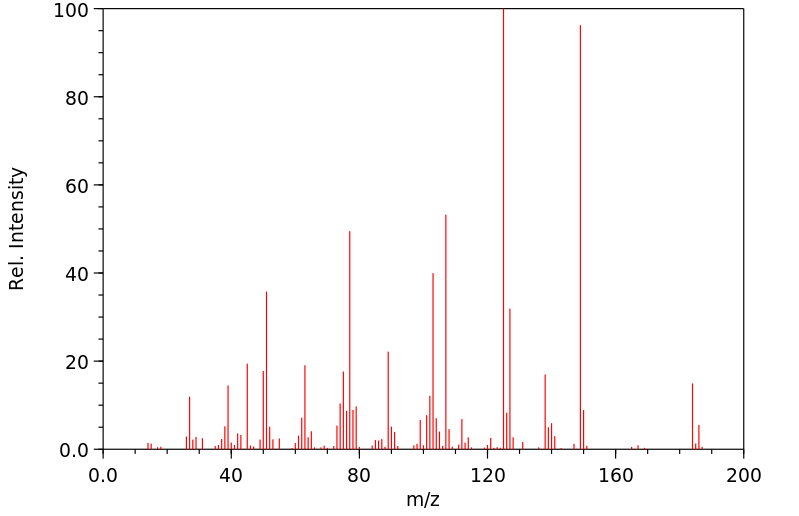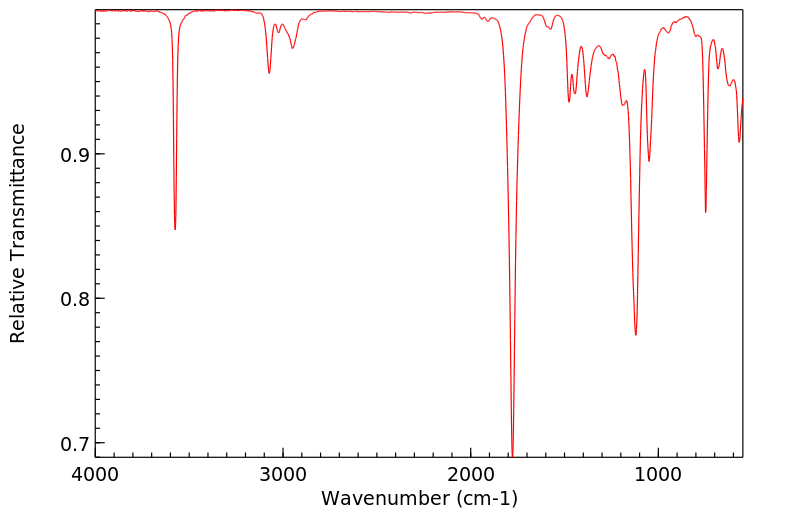3-(2-氯苯基)丙酸 | 1643-28-3
中文名称
3-(2-氯苯基)丙酸
中文别名
邻氯苯丙酸;3-(2-氯苯基)-丙酸
英文名称
3-(2-chlorophenyl)propanoic acid
英文别名
3-(2-chlorophenyl)propionic acid;1-(2-carboxyethyl)-2-chlorobenzene
CAS
1643-28-3
化学式
C9H9ClO2
mdl
MFCD00016547
分子量
184.622
InChiKey
KZMDFTFGWIVSNQ-UHFFFAOYSA-N
BEILSTEIN
——
EINECS
——
-
物化性质
-
计算性质
-
ADMET
-
安全信息
-
SDS
-
制备方法与用途
-
上下游信息
-
文献信息
-
表征谱图
-
同类化合物
-
相关功能分类
-
相关结构分类
物化性质
-
熔点:94-96°C
-
沸点:171°C 10mm
-
密度:1.1989 (rough estimate)
-
闪点:171°C/10mm
-
稳定性/保质期:
在常温常压下保持稳定,应避免与氧化物接触。
计算性质
-
辛醇/水分配系数(LogP):2.3
-
重原子数:12
-
可旋转键数:3
-
环数:1.0
-
sp3杂化的碳原子比例:0.222
-
拓扑面积:37.3
-
氢给体数:1
-
氢受体数:2
安全信息
-
危险等级:IRRITANT
-
危险品标志:Xi
-
安全说明:S26,S36/37/39
-
危险类别码:R36/37/38
-
海关编码:2916399090
-
危险类别:IRRITANT
-
危险性防范说明:P261,P305+P351+P338
-
危险性描述:H315,H319,H335
-
储存条件:请将容器密封保存,并储存在阴凉、干燥的地方。
SDS
| Name: | 3-(2-Chlorophenyl)Propanoic Acid Material Safety Data Sheet |
| Synonym: | None Know |
| CAS: | 1643-28-3 |
Synonym:None Know
Section 2 - COMPOSITION, INFORMATION ON INGREDIENTS
| CAS# | Chemical Name | content | EINECS# |
| 1643-28-3 | 3-(2-Chlorophenyl)Propanoic Acid | ca. 100 | unlisted |
Risk Phrases: 36/37/38
Section 3 - HAZARDS IDENTIFICATION
EMERGENCY OVERVIEW
Irritating to eyes, respiratory system and skin.
Potential Health Effects
Eye:
Causes eye irritation. May cause chemical conjunctivitis.
Skin:
Causes skin irritation.
Ingestion:
May cause gastrointestinal irritation with nausea, vomiting and diarrhea.
Inhalation:
Causes respiratory tract irritation. Can produce delayed pulmonary edema.
Chronic:
Effects may be delayed.
Section 4 - FIRST AID MEASURES
Eyes: Immediately flush eyes with plenty of water for at least 15 minutes, occasionally lifting the upper and lower eyelids. Get medical aid.
Skin:
Get medical aid. Flush skin with plenty of water for at least 15 minutes while removing contaminated clothing and shoes. Wash clothing before reuse.
Ingestion:
Never give anything by mouth to an unconscious person. Get medical aid. Do NOT induce vomiting. If conscious and alert, rinse mouth and drink 2-4 cupfuls of milk or water. Wash mouth out with water.
Inhalation:
Remove from exposure and move to fresh air immediately. If not breathing, give artificial respiration. If breathing is difficult, give oxygen. Get medical aid. Do NOT use mouth-to-mouth resuscitation.
Notes to Physician:
Treat symptomatically and supportively.
Section 5 - FIRE FIGHTING MEASURES
General Information:
As in any fire, wear a self-contained breathing apparatus in pressure-demand, MSHA/NIOSH (approved or equivalent), and full protective gear. During a fire, irritating and highly toxic gases may be generated by thermal decomposition or combustion.
Extinguishing Media:
Use water spray, dry chemical, carbon dioxide, or chemical foam.
Section 6 - ACCIDENTAL RELEASE MEASURES
General Information: Use proper personal protective equipment as indicated in Section 8.
Spills/Leaks:
Vacuum or sweep up material and place into a suitable disposal container. Clean up spills immediately, observing precautions in the Protective Equipment section. Avoid generating dusty conditions.
Provide ventilation.
Section 7 - HANDLING and STORAGE
Handling:
Minimize dust generation and accumulation. Avoid breathing dust, vapor, mist, or gas. Avoid contact with eyes, skin, and clothing.
Keep container tightly closed. Avoid ingestion and inhalation. Use with adequate ventilation. Wash clothing before reuse.
Storage:
Store in a tightly closed container. Store in a cool, dry, well-ventilated area away from incompatible substances.
Section 8 - EXPOSURE CONTROLS, PERSONAL PROTECTION
Engineering Controls:
Facilities storing or utilizing this material should be equipped with an eyewash facility and a safety shower. Use adequate ventilation to keep airborne concentrations low.
Exposure Limits CAS# 1643-28-3: Personal Protective Equipment Eyes: Wear appropriate protective eyeglasses or chemical safety goggles as described by OSHA's eye and face protection regulations in 29 CFR 1910.133 or European Standard EN166.
Skin:
Wear appropriate protective gloves to prevent skin exposure.
Clothing:
Wear appropriate protective clothing to prevent skin exposure.
Respirators:
Follow the OSHA respirator regulations found in 29 CFR 1910.134 or European Standard EN 149. Use a NIOSH/MSHA or European Standard EN 149 approved respirator if exposure limits are exceeded or if irritation or other symptoms are experienced.
Section 9 - PHYSICAL AND CHEMICAL PROPERTIES
Physical State: Solid
Color: Not available.
Odor: Not available.
pH: Not available.
Vapor Pressure: Not available.
Viscosity: Not available.
Boiling Point: Not available.
Freezing/Melting Point: 95 - 99 deg C
Autoignition Temperature: Not available.
Flash Point: Not available.
Explosion Limits, lower: Not available.
Explosion Limits, upper: Not available.
Decomposition Temperature:
Solubility in water: Not available.
Specific Gravity/Density:
Molecular Formula: C9H9ClO2
Molecular Weight: 184.62
Section 10 - STABILITY AND REACTIVITY
Chemical Stability:
Stable at room temperature in closed containers under normal storage and handling conditions.
Conditions to Avoid:
Incompatible materials, dust generation, excess heat.
Incompatibilities with Other Materials:
Oxidizing agents.
Hazardous Decomposition Products:
Hydrogen chloride, carbon monoxide, carbon dioxide.
Hazardous Polymerization: Has not been reported
Section 11 - TOXICOLOGICAL INFORMATION
RTECS#:
CAS# 1643-28-3 unlisted.
LD50/LC50:
Not available.
Carcinogenicity:
3-(2-Chlorophenyl)Propanoic Acid - Not listed by ACGIH, IARC, or NTP.
Section 12 - ECOLOGICAL INFORMATION
Section 13 - DISPOSAL CONSIDERATIONS
Dispose of in a manner consistent with federal, state, and local regulations.
Section 14 - TRANSPORT INFORMATION
IATA
Not regulated as a hazardous material.
IMO
Not regulated as a hazardous material.
RID/ADR
Not regulated as a hazardous material.
Section 15 - REGULATORY INFORMATION
European/International Regulations
European Labeling in Accordance with EC Directives
Hazard Symbols: XI
Risk Phrases:
R 36/37/38 Irritating to eyes, respiratory system
and skin.
Safety Phrases:
S 26 In case of contact with eyes, rinse immediately
with plenty of water and seek medical advice.
S 37/39 Wear suitable gloves and eye/face
protection.
WGK (Water Danger/Protection)
CAS# 1643-28-3: No information available.
Canada
None of the chemicals in this product are listed on the DSL/NDSL list.
CAS# 1643-28-3 is not listed on Canada's Ingredient Disclosure List.
US FEDERAL
TSCA
CAS# 1643-28-3 is not listed on the TSCA inventory.
It is for research and development use only.
SECTION 16 - ADDITIONAL INFORMATION
N/A
上下游信息
-
上游原料
中文名称 英文名称 CAS号 化学式 分子量 3-(2-氯苯基)丙酸甲酯 methyl 3-(2-chlorophenyl)propanoate 74124-86-0 C10H11ClO2 198.649 3-(2-氯苯基)丙酸乙酯 ethyl 3-(2-chlorophenyl)propanoate 30573-88-7 C11H13ClO2 212.676 3-(2-氯苯基)丙腈 2-chlorohydrocinnamonitrile 7315-17-5 C9H8ClN 165.622 3-苯基丙酸 3-Phenylpropionic acid 501-52-0 C9H10O2 150.177 2-(2-氯苄基)丙二酸二乙酯 diethyl 2-(2-chlorobenzyl)malonate 77738-21-7 C14H17ClO4 284.74 2-氯苯乙醇 2-(2-chlorophenyl)-1-ethanol 19819-95-5 C8H9ClO 156.612 2-氯苯乙基溴 1-(2-bromoethyl)-2-chlorobenzene 16793-91-2 C8H8BrCl 219.509 -
下游产品
中文名称 英文名称 CAS号 化学式 分子量 3-(2-氯苯基)丙酸甲酯 methyl 3-(2-chlorophenyl)propanoate 74124-86-0 C10H11ClO2 198.649 3-(2-氯苯基)-丙醛 3-(2-chlorophenyl)propanal 157433-36-8 C9H9ClO 168.623 3-(2-氯苯基)-1-丙醇 3-(2-chlorophenyl)propan-1-ol 6282-87-7 C9H11ClO 170.639 —— rac-3-(2-chlorophenyl)-2-hydroxypropionic acid 133373-31-6 C9H9ClO3 200.622 3-(2-氯苯基)丙酰氯 3-(2-chlorophenyl)propionyl chloride 52085-97-9 C9H8Cl2O 203.068 —— 3-(2-chlorophenyl)propanamide 134306-93-7 C9H10ClNO 183.637 —— 4-(2-chlorophenyl)-2-methylbutan-2-ol 87077-62-1 C11H15ClO 198.692 3-(2-氯苯基)-1-丙胺 3-(2-chlorophenyl)-1-propanamine 18655-48-6 C9H12ClN 169.654 —— N-methyl-3-(2-chlorophenyl)propionamide 103753-47-5 C10H12ClNO 197.664 3-(2-氯苯基)-N-甲基丙烷-1-胺 N-[3-(2-chlorophenyl)propyl]-N-methylamine 103273-66-1 C10H14ClN 183.681 —— 1-diazo-4-(2-chlorophenyl)butan-2-one 365553-89-5 C10H9ClN2O 208.647 —— 3-(2-chlorophenyl)-1-phenylpropan-1-one 54197-71-6 C15H13ClO 244.721 —— 3-(2-chlorophenyl)-1-(4-methylphenyl)-1-propanone —— C16H15ClO 258.748 —— 1-[3-(2-Chlorophenyl)propyl]piperazine 59214-24-3 C13H19ClN2 238.76 4-氯-2,3-二氢-1H-茚 4-chloro-indan 15115-61-4 C9H9Cl 152.623 5-(2-氯苯基)-1-苯基戊烷-1,3-二酮 5-(2-chlorophenyl)-1-phenylpentane-1,3-dione 24118-66-9 C17H15ClO2 286.758 - 1
- 2
反应信息
-
作为反应物:描述:参考文献:名称:Structure–Activity relationship of linear peptide Bu-His-DPhe-Arg-Trp-Gly-NH2 at the human melanocortin-1 and -4 receptors: histidine substitution摘要:Systematic substitution of His(6) residue using non-selective hMC4R pentapeptide agonist (Bu-His(6)-DPhe(7)-Arg(8)-Trp(9)-Gly(10)- NH2) as the template led to the identification of Bu-Atc(6)(2-aminotetraline-2-carboxylic acid)-DPhe(7)-Arg(8)-Trp(9)-Gly(10)-NH2 which showed moderate selectivity towards hMC4R over hMC1R. Further SAR studies resulted in the discovery of Penta-5-BrAtc(6)-DPhe(7)-Arg(8)-Trp(9)-Gly(10)-NH2 and Penta-5-Me(2)NMAtc(6)-DPhe(7)-Arg(8)-Trp(9)-Gly(10)-NH2 which are potent hMC4R agonists and are inactive in hMC1R, hMC3R and hMC5R agonist assays. (C) 2002 Published by Elsevier Science Ltd.DOI:10.1016/s0960-894x(02)00830-2
-
作为产物:描述:参考文献:名称:肉桂酸的二碘化钐还原摘要:通过使用 GC 或 GC/MS 以及 HPLC 作为检测工具,测量 SmI2 还原率的方法扩展到更广泛的有机化合物。还原底物不仅限于水不溶性化合物或仅低沸点化合物。为此应用选择了高沸点的水溶性肉桂酸衍生物。在六甲基磷酰胺或叔丁醇存在下,SmI2 还原肉桂酸的绝对速率常数被认为是该反应中合适的质子源。速率取决于底物和添加剂,如: 速率 ∞ [t-BuOH][肉桂酸] 和速率 ∞ [HMPA][肉桂酸] α-甲基肉桂酸、2-甲基肉桂酸、4-甲基肉桂酸、 2-甲氧基肉桂酸、3-甲氧基肉桂酸、4-甲氧基肉桂酸、DOI:10.1002/jccs.200400136
文献信息
-
NOVEL COMPOUNDS AS CANNABINOID RECEPTOR LIGANDS AND USES THEREOF申请人:Florjancic S. Alan公开号:US20080058335A1公开(公告)日:2008-03-06The present invention relates to compounds of formula (I), or pharmaceutical salts, prodrugs, salts of prodrugs, or combinations thereof, wherein R 1 , R 2 , R 3 , and L 1 are defined in the specfication, compositions comprising such compounds, and methods of treating conditions and disorders using such compounds and compositions. The present invention also relates to compounds of formula (II), or pharmaceutical salts, prodrugs, salts of prodrugs, or combinations thereof, wherein R 1a , R 2a and (Rx)n are as defined in the specification, compositions comprising such compounds, and methods of treating conditions and disorders using such compounds and compositions.本发明涉及式(I)的化合物,或药用盐、前药、前药的盐或其组合物, 其中R 1 ,R 2 ,R 3 和L 1 在规范中定义,包含这种化合物的组合物,以及使用这种化合物和组合物治疗疾病和疾病的方法。本发明还涉及式(II)的化合物,或药用盐、前药、前药的盐或其组合物, 其中R 1a ,R 2a 和(Rx)n如规范中定义,包含这种化合物的组合物,以及使用这种化合物和组合物治疗疾病和疾病的方法。
-
Asymmetric Synthesis of Nonracemic Primary Amines via Spiroborate-Catalyzed Reduction of Pure (<i>E</i>)- and (<i>Z</i>)-<i>O</i>-Benzyloximes: Applications toward the Synthesis of Calcimimetic Agents作者:Wenhua Ou、Sandraliz Espinosa、Héctor J. Meléndez、Silvia M. Farré、Jaime L. Alvarez、Valerie Torres、Ileanne Martínez、Kiara M. Santiago、Margarita Ortiz-MarcialesDOI:10.1021/jo400371x日期:2013.6.7Highly enantiopure (1-aryl)- and (1-naphthyl)-1-ethylamines were synthesized by the borane-mediated reduction of single-isomeric (E)- and (Z)-O-benzyloxime ethers using the stable spiroborate ester derived from (S)-diphenyl valinol and ethylene glycol as the chiral catalyst. Primary (R)-arylethylamines were prepared by the reduction of pure (Z)-ethanone oxime ethers in up to 99% ee using 15% of catalyst
-
[EN] SUBSTITUTED BENZAMIDE DERIVATIVES<br/>[FR] DÉRIVÉS DE BENZAMIDE SUBSTITUÉS申请人:HOFFMANN LA ROCHE公开号:WO2011076678A1公开(公告)日:2011-06-30The invention relates to compounds of formula I wherein R is hydrogen or lower alkyl; R1 is -(CH2)n-(O)o-heterocycloalkyl or -C(O)-heterocycloalkyl, wherein the heterocycloalkyl group is optionally substituted by lower alkyl, hydroxy, halogen or by -(CH2)p-aryl; n is 0, 1 or 2; o is 0 or 1; p is 0, 1 or 2; R2 is CF3, cycloalkyl, optionally substituted by lower alkoxy or halogen, or is indan-2-yl, or is heterocycloalkyl, optionally substituted by heteroaryl, or is aryl or heteroaryl, wherein the aromatic rings are optionally substituted by one or two substituents, selected from lower alkyl, halogen, heteroaryl, hydroxy, CF3, OCF3, OCH2CF3, OCH2-cycloalkyl, OCH2C(CH2OH)(CH2C1)(CH3), S-lower alkyl, lower alkoxy, CH2-lower alkoxy, lower alkinyl or cyano, or by-C(O)-phenyl, -O-phenyl, -O- CH2-phenyl, phenyl or -CH2-phenyl, and wherein the phenyl rings may optionally be substituted by halogen, -C(O)-lower alkyl, -C(O)OH or -C(O)O-lower alkyl, or the aromatic rings are optionally substituted by heterocycloalkyl, OCH2-oxetan-3-yl or O-tetrahydropyran-4-yl, optionally substituted by lower alkyl; X is a bond, -NR'-, -CH2NH-, -CHR''-, -(CHR'')q-O-, -O-(CHR'')q- or -(CH2)2-; Y is a bond or -CH2- R' is hydrogen or lower alkyl, R'' is hydrogen, lower alkyl, CF3, lower alkoxy, q is 0, 1, 2 or 3; or to a pharmaceutically suitable acid addition salt thereof. It has now been found that the compounds of formula I have a good affinity to the trace amine associated receptors (TAARs), especially for TAAR1. The compounds may be used for the treatment of depression, anxiety disorders, bipolar disorder, attention deficit hyperactivity disorder (ADHD), stress-related disorders, psychotic disorders such as schizophrenia, neurological diseases such as Parkinsons disease, neurodegenerative disorders such as Alzheimers disease, epilepsy, migraine, hypertension, substance abuse and metabolic disorders such as eating disorders, diabetes, diabetic complications, obesity, dyslipidemia, disorders of energy consumption and assimilation, disorders and malfunction of body temperature homeostasis, disorders of sleep and circadian rhythm, and cardiovascular disorders.该发明涉及以下式I的化合物,其中R是氢或较低的烷基;R1是-(CH2)n-(O)o-杂环烷基或-C(O)-杂环烷基,其中杂环烷基基团可选择地被较低的烷基,羟基,卤素或-( )p-芳基取代;n为0、1或2;o为0或1;p为0、1或2;R2为CF3,环烷基,可选择地被较低的烷氧基或卤素取代,或为茚-2-基,或为杂环烷基,可选择地被杂芳基取代,或为芳基或杂芳基,其中芳香环可选择地被来自较低的烷基,卤素,杂芳基,羟基, ,O ,O ,O -环烷基,O C( OH)( C1)(CH3),S-较低的烷基,较低的烷氧基, -较低的烷氧基,较低的炔基或氰基,或-C(O)-苯基,-O-苯基,-O- -苯基,苯基或- -苯基选择的一个或两个取代基取代,其中苯环可选择地被卤素,-C(O)-较低的烷基,-C(O)OH或-C(O)O-较低的烷基取代,或芳香环可选择地被杂环烷基,O -氧杂环戊烷-3-基或O-四氢吡喃-4-基,可选择地被较低的烷基取代;X为键,-NR'-,- NH-,-CHR''-,-(CHR'')q-O-,-O-(CHR'')q-或-( )2-;Y为键或- -;R'为氢或较低的烷基,R''为氢,较低的烷基, ,较低的烷氧基,q为0、1、2或3;或其药学上适宜的酸盐。现已发现,该式I的化合物对痕量胺相关受体(TAARs)具有良好的亲和力,特别是对于TAAR1。这些化合物可用于治疗抑郁症,焦虑症,躁郁症,注意力缺陷多动障碍(ADHD),与压力有关的疾病,如精神分裂症,帕金森病等神经疾病,阿尔茨海默病等神经退行性疾病,癫痫,偏头痛,高血压,物质滥用和代谢性疾病,如进食障碍,糖尿病,糖尿病并发症,肥胖症,血脂异常,能量消耗和吸收异常,体温稳态异常,睡眠和昼夜节律异常,以及心血管疾病。
-
Continuous‐Flow Amide and Ester Reductions Using Neat Borane Dimethylsulfide Complex作者:Sándor B. Ötvös、C. Oliver KappeDOI:10.1002/cssc.201903459日期:2020.4.7importance in synthetic chemistry, and there are numerous protocols for executing these transformations employing traditional batch conditions. Notably, strategies based on flow chemistry, especially for amide reductions, are much less explored. Herein, a simple process was developed in which neat borane dimethylsulfide complex (BH3 ⋅DMS) was used to reduce various esters and amides under continuous-flow conditions酰胺和酯的还原在合成化学中至关重要,有许多使用传统间歇条件进行这些转化的方案。值得注意的是,很少研究基于流动化学的策略,尤其是酰胺还原的策略。本文中,开发了一种简单的方法,其中使用纯硼烷二甲基硫醚络合物(BH3·DMS)在连续流动条件下还原各种酯和酰胺。利用可商购的硼烷试剂的无溶剂性质,实现了高底物浓度,从而实现了出色的生产率和E因子的显着降低。另外,在精心优化的短停留时间的情况下,以高选择性和高收率获得了相应的醇和胺。药物相关产品的多克级合成进一步证实了廉价且易于实施的流程协议的合成效用。由于其有益的特征,包括低的溶剂和还原剂消耗,高的选择性,简单性和固有的可扩展性,与使用金属氢化物作为还原剂的大多数典型的批量还原相比,本发明的方法对环境的关注较少。
-
A Ligand-Directed Catalytic Regioselective Hydrocarboxylation of Aryl Olefins with Pd and Formic Acid作者:Wei Liu、Wenlong Ren、Jingfu Li、Yuan Shi、Wenju Chang、Yian ShiDOI:10.1021/acs.orglett.7b00507日期:2017.4.7An effective Pd-catalyzed hydrocarboxylation of aryl olefins with Ac2O and formic acid is described. A variety of 2- and 3-arylpropanoic acids can be regioselectively formed by the judicious choice of ligand without the use of toxic CO gas.
表征谱图
-
氢谱1HNMR
-
质谱MS
-
碳谱13CNMR
-
红外IR
-
拉曼Raman
-
峰位数据
-
峰位匹配
-
表征信息
同类化合物
限制性核酸内切酶TAQⅠ(TTHHB8I)
阿明洛芬
阿拉洛芬
铁-N-(3-苯基戊二酰)去铁敏B
钙二[(2R)-2-羟基-3-苯丙酸酯]
酮洛芬相关物质C
酪泮酸钠
酪氨酸,3-羟基-b-亚甲基-
苯基丙酮酸缩氨基脲
苯基丁二酸
苯乙酸,a-甲基-4-(4,5,6,7-四氢-2-苯并噻唑基)-
苯丙酸钠盐
苯丙酸钙盐(2:1)
苯丙酸,加合N-环己基并环己胺(1:1)
苯丙酸,b-[[(苯基氨基)羰基]氨基]-
苯丙酸,b-[[(二乙胺基)硫代甲基]硫代]-
苯丙酸,a-[2-[甲基[2-(4-吗啉基)乙基]氨基]-2-羰基乙基]-,(R)-
苯丙酸,a-[(乙酰基硫代)甲基]-,(S)-
苯丙酸,4-羟基-b,2,6-三甲基-,(bR)-
苯丙酸,4-氯-a-(肟基)-
苯丙酸,3-硝基-b-(三氯甲锗烷基)-
苯丙酸,3-氯-a-羟基-
苯丙酸 羟基-4-甲氧基
苄氧羰基-DL-beta-苯丙氨酸
苄基马来酸
苄基丙二酸单酰肼
苄基丙二酸
苄基丁酸
艾司洛尔酸钠
艾司洛尔酸
胆影脒
羧基布洛芬
羟基布洛芬
美索洛芬
米格列奈
米格列奈
碘芬酸
碘番酸
碘泊酸钠
碘泊酸钙
硬脂酰胺丙基鲸蜡硬脂基二甲基铵甲苯磺酸盐
番石榴酸
甲酪氨酸
甲基多巴杂质A
甲基多巴EP杂质B
甲基多巴
甲基3-(4-苄氧基-2-甲基-苯基)丙酸酯
消旋甲酪氨酸
消旋布洛芬赖氨酸盐
消旋卡多曲二元酸杂质








